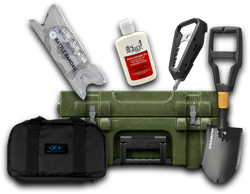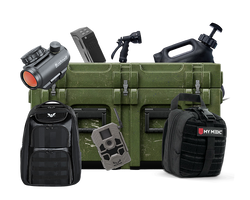
Firearm Suppressor - Uses and How to Obtain One
Firearm suppressors are increasingly popular in the United States. Both casual shooters and hunters choose to use a silencer for various reasons. Firstly, it reduces the risk of hearing damage from gun blast noises. Secondly, it makes hunting even quieter and exciting for deerstalkers.
A silencer has multiple uses for shooters. And, thanks to the latest legislative relaxations, you can easily purchase a suppressor for your licensed gun or rifle. Read on to find out how!
What is a Firearm Suppressor?
A suppressor or silencer is a muzzle that significantly reduces the sound a gun makes when firing. While the noises of the discharge and recoil are substantially lower, they are never completely silent.
Depending on the state and legislation, you may find firearm suppressors under different denominations, such as a gun or silencer, sound moderator or sound can.
The first silencer was designed by American inventor Hiram Percy Maxim, son of Maxim gun inventor Hiram Stevens Maxim in 1902. He received a patent for the device in 1909. Maxim successfully proved its efficiency in lowering the sounds of blasting guns. So, the suppressor quickly entered standard use for the army and the agents of the United States Office of Strategic Services.
What Are the Uses of Firearm Silencers?
In movies, gun silencers usually appear as aides of silent criminals. Perpetrators and assassins use them to ensure that their crimes are muffled and discrete. However, in real life, firearm suppressors have a wide range of uses with significantly fewer criminal implications, such as:
- Hunting purposes
- Reduced noise pollution
- Diminished recoil
- Reduced muzzle blast
- Lower risk of hearing damage
- Better accuracy
An efficient suppressor can help you sneak on your prey silently when hunting. However, it will not help you shoot multiple targets in a row, such as a group of wild pigs, without them noticing. Contrary to popular misconception, this device is not silent enough for you to kill one boar after another while they remain blissfully ignorant to your discrete gun sounds.
How a Firearm Suppressor Works
Nowadays, most firearms are designed to support projectiles traveling at supersonic speeds. For instance, modern rifles enable bullets to travel at roughly 1,100 feet per second. Sometimes, they leave the barrel even faster than that.
Even the latest firearm suppressors cannot cover the sound of a supersonic traveling bullet entirely. However, it can dampen the noise enough to reduce noise pollution and the risk of hearing damage.
Think of the firearm suppressor as the muffler on a car. Most modern mufflers do an excellent job at reducing exhaust noises from an automobile. Still, it does not make cars traveling completely silent.
The common silencer is a metallic device in the form of a cylinder. It fits as a prolongation of the firearm barrel. More so, it employs a series of internal sound baffles around a long and hollow bore. This way, the bullet can still exit the barrel of the gun without any hindrance.
Types of Firearm Suppressors
There are several types of firearm suppressors. However, there are only three kinds of silencers that you will find most common in gun shops, regardless of the state they are in, and they include:
1. Direct Thread
This suppressor attaches to a barrel with threads. Generally, you can use it for rimfire and centerfire guns. Its primary advantage is that you can use it on multiple firearms.
2. Quick Detach
This suppressor attaches faster to the gun barrel than the direct thread silencer. Usually, you need to couple it with a muzzle brake or a flash hider instead of connecting it with the barrel directly. You can also use it on multiple firearms. More so, it increases the accuracy of your firing a bit more than the direct thread.
3. Integral Suppressor
This silencer is designed as an integral part of the barrel of a firearm. Simply put, it is attached to the gun at all times. So, you cannot remove it or use it with other firearms.
Why You Should Use a Firearm Silencer
According to the American Speech-Language-Hearing Association, exposure to noise higher than 140 decibels may damage your hearing permanently. The problem is that most firearms produce a noise greater than this limit. For instance, a big-bore rifle release sounds higher than 175 dB.
If you care about your health and of those around you, a silencer is one of the best investments you can make. Keep it in your hunting gear because your earplugs may not always protect you from potential hearing damage.
Law Requirements for Using Firearm Suppressors
The use of firearm suppressors is regulated under the National Firearms Act (NFA) of 1934, which is a branch of the Bureau of Alcohol, Tobacco, Firearms, and Explosives (BATFE). According to the legislation, you can register this device as an individual, a company, or a living trust.
If you want to purchase a firearm suppressor, you must meet these legal conditions:
- You must be at least 21 years of age to buy it from a dealer.
- You must be at least 18 years of age to buy it from an individual on an ATF Form 4 to ATF Form 4 transfer.
- You must be at least 18 years of age to possess a firearm suppressor as a beneficiary of a trust or as a member of a corporation.
- You must be a resident of the United States.
- You must be legally eligible to purchase a firearm.
- You must pass a BATFE background check.
- You have to pay a $200 Transfer Tax.
What States Allow Silencers?
At the time of this writing, only 39 states in the US allow civilians to own firearm suppressors. These states include:
Alabama, Arkansas, Alaska, Arizona, Colorado, Connecticut, Florida, Georgia, Idaho, Indiana, Kansas, Kentucky, Louisiana, Maryland, Maine, Michigan, Mississippi, Missouri, Montana, North Dakota, Nebraska, Nevada, New Hampshire, New Mexico, North Carolina, Ohio, Oklahoma, Oregon, Pennsylvania, South Carolina, South Dakota, Tennessee, Texas, Utah, Virginia, Washington, Wisconsin, West Virginia, and Wyoming.
How to Obtain a Firearm Suppressor
If you want to buy a firearm suppressor and you also meet the legal requirements to do so, you have to follow these steps:
- Find a Class III Dealer in your state of residence.
- Provide the prospective purchaser (transferee) with the ATF Form 4 in duplicate.
- Have a law enforcement agency sign your fingerprints before submission.
- Submit your fingerprints on the FBI Form FD-258, in duplicate.
- Submit 2” x 2” passport photos taken within the past year.
- Have a chief law enforcement officer verify your criminal record and complete the “Law Enforcement Certification” section on the rear of the ATF Form 4
- Mail the complete paperwork to the Department of the Treasury with a check or money order for $200 known as a transfer tax.
The approval process takes between nine and twelve months. Only after the NFA stamps the ATF Form 4 can the dealer transfer the possession of the suppressor to the new owner.
Share this article








